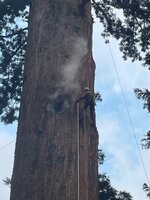From the US Forest Service, Sierra National Forest.
View attachment 147048#GarnetFire
Saving the Giant Sequoia Calls for a Special Team of Firefighters
McKinley Grove, CA — Nestled in the mountains just outside of Fresno, California, live some of the oldest and largest trees in the world. The giant sequoia is known for its staggering height and circumference that exceed that of a small house. Giant sequoia are among the longest-living trees, with many exceeding 2,000 years of age, and are limited to California’s Sierra Nevada. McKinley Grove is home to some of the tallest and oldest living organisms on Earth. These trees have withstood the test of time, surviving centuries of naturally occurring wildfires, storms, droughts, and floods. Ecologically, giant sequoias are fire-adapted species, genetically predisposed to thrive despite the natural effects of fires that have occurred for centuries.
On August 24, 2025, lightning struck the Sierra National Forest, igniting what is now known as the Garnet Fire. Fire crews from across the region have been working diligently to protect valuable social, economic, and ecological resources at risk from this large-scale wildfire. As the fire approached the giant sequoias in McKinley Grove, a rare and specialized team was called in to tackle this extraordinary challenge.
A Grove Worth Protecting
As the Garnet Fire approached McKinley Grove, strong winds drove convective heat and embers into the crown of these trees, posing a unique challenge – small crown fires in the massive canopies of the giant sequoias.
In response to the threat, the Incident Management Team instructed firefighters to clear the understory brush from the grove. They also deployed ground crews to establish fire lines and set up sprinklers to douse the bases of the sequoias with water. Yet, the hot embers, blown by the erratic winds from the approaching wildfire, started fires in the canopy of some of the trees. The task of extinguishing fires in the treetops required a team with unparalleled skills: the Redding Smokejumpers of the U.S. Forest Service.
Scaling Giants
Typically trained to parachute into remote fire locations for rapid response, the Redding Smokejumpers employed a different set of tools at McKinley Grove. Utilizing specialized climbing ropes, harnesses, and projectile systems to launch lines into the tree canopy, they ascended into the upper branches of the giant sequoias. Once there, they hoisted garden-hose-sized lines and nozzle extensions to spray water into cavities where the hot embers had settled.
Smokejumper Mitch Hoakanson, a veteran with 26 years of experience, described the unique challenges of the mission: “Yesterday, the first branch we encountered was 150 feet above the ground, and typically, the trees we climb are around 150 feet tall. In fact, some of the sequoias in McKinley Grove tower over 230 feet.” This presented an interesting challenge for these skilled firefighters, but they were successful in accessing the burning sections of the trees to extinguish the fires. Every fire assignment is unique for the Redding Smokejumpers, but this one carried the important job of protecting the legacy of the Giant Sequoia.
#ReddingSmokeJumpers



 .
. 
